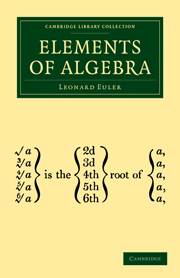Book contents
- Frontmatter
- ADVERTISEMENT
- MEMOIR OF THE LIFE AND CHARACTER OF EULER, BY THE LATE FRANCIS HORNER, ESQ., M. P.
- ADVERTISEMENT BY THE EDITORS OF THE ORIGINAL, IN GERMAN
- ADVERTISEMENT BY M. BERNOULLI, THE FRENCH TRANSLATOR
- Contents
- PART I Containing the Analysis of Determinate Quantities
- SECTION I Of the Different Methods of calculating Simple Quantities
- SECTION II Of the different Methods of calculating Compound Quantities
- SECTION III Of Ratios and Proportions
- SECTION IV Of Algebraic Equations, and of the Resolution of those Equations
- PART II Containing the Analysis of Indeterminate Quantities
- ADDITIONS BY M. DE LA GRANGE
- Advertisement
- Chap. I Of Continued Fractions
- Chap. II Solution of some New and Curious Arithmetical Problems
- Chap. III Of the Resolution in Integer Numbers of Equations of the First Degree containing two Unknown Quantities
- Chap. IV General Method for resolving in, Integer Equations of two Unknown Quantities, one of which does not exceed the First Degree
- Chap. V A direct and general Method for finding the values of x, that will render Rational Quantities of the form √(a + bx + cx2), and for resolving, in Rational Numbers, the indeterminate Equations of the second Degree, which have two Unknown Quantities, when they admit of Solutions of this kind
- Chap. VI Of Double and Triple Equalities
- Chap. VII A direct and general Method for finding all the values of y expressed in Integer Numbers, by which we may render Quantities of the form √(Ay2 + B), rational, A and B being given Integer Numbers; and also for finding all the possible Solutions, in Integer Numbers, of indeterminate Quadratic Equations of two unknown Quantities
- Chap. VIII Remarks on Equations of the Form p2=Aq2 + 1, and on the common Method of resolving them in whole Numbers
Chap. II - Solution of some New and Curious Arithmetical Problems
Published online by Cambridge University Press: 05 July 2011
- Frontmatter
- ADVERTISEMENT
- MEMOIR OF THE LIFE AND CHARACTER OF EULER, BY THE LATE FRANCIS HORNER, ESQ., M. P.
- ADVERTISEMENT BY THE EDITORS OF THE ORIGINAL, IN GERMAN
- ADVERTISEMENT BY M. BERNOULLI, THE FRENCH TRANSLATOR
- Contents
- PART I Containing the Analysis of Determinate Quantities
- SECTION I Of the Different Methods of calculating Simple Quantities
- SECTION II Of the different Methods of calculating Compound Quantities
- SECTION III Of Ratios and Proportions
- SECTION IV Of Algebraic Equations, and of the Resolution of those Equations
- PART II Containing the Analysis of Indeterminate Quantities
- ADDITIONS BY M. DE LA GRANGE
- Advertisement
- Chap. I Of Continued Fractions
- Chap. II Solution of some New and Curious Arithmetical Problems
- Chap. III Of the Resolution in Integer Numbers of Equations of the First Degree containing two Unknown Quantities
- Chap. IV General Method for resolving in, Integer Equations of two Unknown Quantities, one of which does not exceed the First Degree
- Chap. V A direct and general Method for finding the values of x, that will render Rational Quantities of the form √(a + bx + cx2), and for resolving, in Rational Numbers, the indeterminate Equations of the second Degree, which have two Unknown Quantities, when they admit of Solutions of this kind
- Chap. VI Of Double and Triple Equalities
- Chap. VII A direct and general Method for finding all the values of y expressed in Integer Numbers, by which we may render Quantities of the form √(Ay2 + B), rational, A and B being given Integer Numbers; and also for finding all the possible Solutions, in Integer Numbers, of indeterminate Quadratic Equations of two unknown Quantities
- Chap. VIII Remarks on Equations of the Form p2=Aq2 + 1, and on the common Method of resolving them in whole Numbers
Summary
Although the problems, which we are now to consider, are immediately connected with the preceding, and depend on the same principles, it will be proper to treat of them in a direct manner, without supposing any thing of what has been before demonstrated: by which means we shall have the satisfaction of seeing how necessarily these subjects lead to the theory of Continued Fractions. Besides, this theory will be rendered much more evident, and receive from it a greater degree of perfection.
23. Problem 1. A positive quantity a, whether rational or not, being given, to find two integer positive numbers, p and q, prime to each other; such, that p − aq (abstracting from the sign), may be less than it would be, if we assigned to p and q any less values whatever.
- Type
- Chapter
- Information
- Elements of Algebra , pp. 495 - 529Publisher: Cambridge University PressPrint publication year: 2009First published in: 1822

